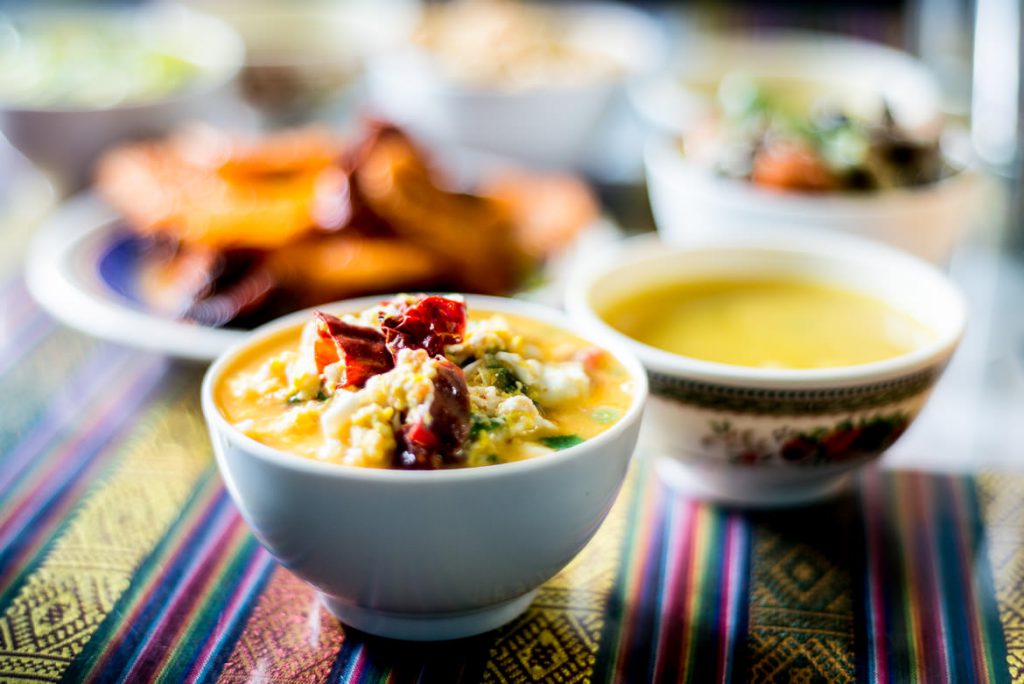Rice, buckwheat and increasingly maize, are the staples of Bhutanese cuisine. The local diet also includes pork, beef, yak meat chicken, and mutton Soups and stews of meat and dried vegetables spiced with chilies and cheese are prepared. Ema datshi, made very spicy with cheese and chilies, might be called the national dish for its ubiquity and the pride that Bhutanese have for it. Dairy foods, particularly butter and cheese from yaks and cows, are also popular, and indeed almost all milk is turned to butter and cheese. Popular beverages include butter tea, tea, locally brewed ara (rice wine) and beer. Bhutan is the first country in the world to have banned the sale of tobacco under its Tobacco Act of 2010 to be an art, mastered to attain physical dexterity, mental strength and highest spirit of competition.
Food and Drinks
Bhutanese food is generally good. Set meals for travelers tend to be on the bland side, because local food is heavily seasoned with red chilies and can be quite hot. Most hotels provide meals buffet-style. There are usually continental, Indian, Chinese and Bhutanese dishes. The food in hotels is often the best in the town, but in main towns now there are few restaurants increasingly becoming popular. All tourist hotels have good selection of international and Bhutanese beverages.

Cooking Method
The Bhutanese cook meats and vegetables with water and oil. Using this method, most dishes can be made in very less time. Although Bhutanese method of cooking food is quite simple, yet the food is delicious. It could come as surprise for those who are accustomed to cooking food employing complex methods.
Use of Chili
Chilies are used in preparing almost all Bhutanese dishes. Other than the chilies, there are few ingredients. Bhutanese don’t use spices in cooking their food. Just with chili and salt, they can cook delicious food.
Rice
Bhutanese consume rice with their meat and vegetables. The dishes are accompanied by rice. They are fond of red rice, with is a short grain of light, nutty flavor. Red rice is the part of every Bhutanese banquet. Sometimes, rice is flavored with saffron.
Other preferences
Bhutanese are fond of eating cheese. Cow’s milk cheese is loved by them. Yak cheese is also a preference. Apple orchards are abundant in the country which also produces more than 400 varieties of mushroom. Meat and fish are usually imported from India. Most popular beverage among the locals is Bhutanese tea, known as Souza. Tipping is usually not practiced in
Bhutanese restaurants.
Just like the many different landscapes, Bhutanese cuisine is just as varied and splendid and every region knows its own specialty. Dairy foods, in particular butter and cheese from yaks and cows, are very popular. A lot of meat and poultry like chicken, pork, beef, goat, mutton and yak is consumed, as well as fish. These are usually served in the form of stews (tshoem), within it a wide variety of fresh vegetables and spices like cardamom, ginger, caraway and turmeric. All meals are accompanied by white rice (ha chum) or pink-red rice (eue chum), which is steamed or boiled. Besides rice also buckwheat and maize are used.
If there’s one thing typical for Bhutanese cuisine, it is that the Bhutanese love it spicy! Chilies are not considered to be a seasoning, but a true and valuable vegetable. Therefore traditional Bhutanese food is lavishly spiced with dried or fresh red and green chilies. How can it be any other way than that Bhutan’s favorite ingredient is processed in its national dish? While in Bhutan, you ought to try the national dish of Ema-Datsi, consisting of ema (chili) cooked in datsi (cheese). Everybody has their own interpretations of this recipe and it will excite your senses for sure!
Bhutanese peppers
If you don’t like it so spicy, don’t be worried. Most of Bhutan’s professional chefs take into account the Western less spicy taste. You can choose from Continental to Chinese and from Bhutanese to Tibetan and Indian cuisine. Most hotels offer dinner in buffet style.
Although (sweet milk) tea is a popular beverage in Bhutan, most people prefer Sura. This saltered butter tea is served on all social occasions. Regarding water, you should better not drink tap water, but choose mineral water. During trekking the water is boiled and therefore safe to drink. Regarding alcohol, the chang (local beer) and arra (a spirit distilled from rice, maize, wheat or barley) are common and very much favored. They are easily available in bars, except on Tuesday (dry day). The legal drinking age is 18 years and above. Doma (betel nut) is offered as a customary gesture of greeting. Since 2004 Bhutan is the world’s only country where public smoking is prohibited. If you’re a smoker, you’re allowed however to import tobacco to use indoors, but you have to pay an import tax of 100%.
Tip: when you’re offered food, you can say “meshu meshu”, covering your mouth with the hands in refusal according to Bhutanese manners, and then give in on the second or third offer.
On Cultural Tour
BREAKFAST; canned juice with choice of orange, mango, pineapple, apple etc, porridge/cornflakes/cereals, fresh fruits, sausages/bacon, toast, butter and jam, eggs, tea/coffee.
LUNCH; salad, rice, for non- vegetable items, vegetable items, roti/nan, desert, tea/ coffee.
DINNER; Soup, salad, rice, noodles, non- vegetable items, vegetable items, desert, tea/coffee.
EVENING TEA; tea/coffee, cookies/sandwich, biscuit/pasteries.
On Trek
BREAKFAST; canned juice with choice of orange, mango, pineapple, apple etc, porridge/cornflakes/cereals, fresh fruits, sausages/bacon, toast, butter and jam, eggs, tea/coffee.
LUNCH; vegetable cutlet/sandwich/boiled potato, chicken roast, beef roast, boiled eggs, roti/naan, fresh fruits, canned juice, boiled drinking water.
DINNER; Soup, salad, rice, noodles, non- vegetable items, vegetable items, desert, tea/coffee.
EVENING TEA; tea/ coffee, cookies/sandwich and biscuits.